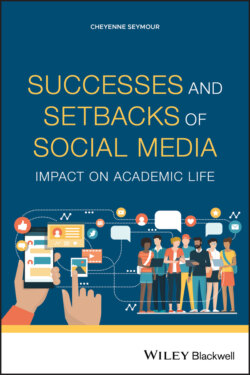Читать книгу Successes and Setbacks of Social Media - Группа авторов - Страница 13
Social Media Groups and Good Grades
ОглавлениеTraditionally, many students clock hours engaging in class, reading, completing assignments, and more to achieve high marks in their respective courses. As faculty develop lesson plans and flip classes, “where events that have traditionally taken place inside the classroom now take place outside the classroom and vice versa” (Lage et al. 2000, p. 32), social media continues to gain traction among students and educators. Two popular platforms being used for educational purposes are Facebook and Twitter; use of these sites can lead to better academic performance for those working to obtain degrees. Writing is a part of the college experience. Regardless of major, students will have to express themselves and synthesize the ideas of others many times during their careers as students. As a microblogging site, Twitter lends itself to self-expression in a limited number of characters. One researcher found the platform helped students strengthen writing skills and connect with audiences. “The brevity of the tweets forces students to express their thoughts concisely and is believed to develop reflection and writing skills while expanding the class community” (Kassens 2014). The ability to communicate a focused message is a transferable skill that will benefit students in class and the workplace.
Although many college and university classrooms may not have literal bells ringing to signal the end of a lecture, the time spent in class is monitored. There are only so many minutes in a day and hours in a week that students can spend in a classroom parsing information, posing questions, and sharing their interpretations. However, Facebook allows students and faculty to expound upon in-class discussions or bring forth new points for class exploration. Gregory et al. (2014) report that participation in Facebook groups for class-related discussions resulted in higher grades when compared to participation levels of students in the same course without the required use of the platform. A study of an introductory mass media course, designed with the option to access supplemental course material on Facebook, uncovered that university students who voluntarily used the social site achieved higher grades at the end of the course (Bowman and Akcaoglu 2014). There’s evidence to suggest that using social platforms in courses can aid in comprehension. In one study, the use of Facebook led to undergraduates understanding an increased amount of course content (Hurt et al. 2012). Twitter has also been found to improve grades among students. In a study comparing two large lectures, with one designed to incorporate the microblogging platform, Junco et al. (2013) found “requiring students to use Twitter as part of the course is important in affecting academic outcomes” (p. 284). Social media is becoming a central part of higher education for both digital natives and digital immigrants, whether one was born into the world of digital media or their fingers stumbled upon it later in life.
